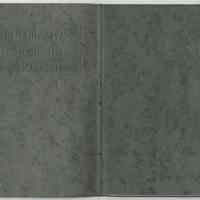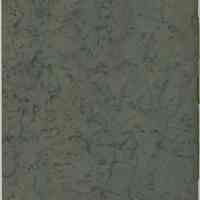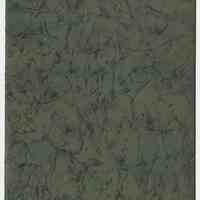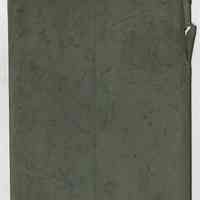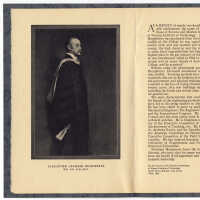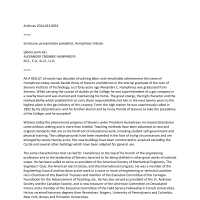Collections Item Detail
Booklet: Stevens Institute of Technology 1871 -1921.
2014.013.0051
2014.013
Lukacs, Claire
Gift
Museum Collections. Gift of a friend of the Museum.
1750 - 1921
Date(s) Created: 1898, 1921 Date(s): 1750-1921
Good
Notes: Archives 2014.013.0051 ==== Enclosure, presentation pamphlet, Humphreys tribute: [photo portrait] ALEXANDER CROMBIE HUMPHREYS M.E., E.D., Sc.D., LL.D. ==== AS A RESULT of nearly two decades of untiring labor and remarkable achievement the name of Humphreys today stands beside those of Stevens and Morton in the eternal gratitude of the men of Stevens Institute of Technology. Just forty years ago Alexander C. Humphreys was graduated from Stevens. While carrying the course of studies at the College he was superintendent of a gas company in a nearby town and was married and maintaining his home. The great energy, the high character and the marked ability which enabled him to carry these responsibilities led him in the next twenty years to the highest place in the gas industry of this country. From this high station he was unanimously called in 1902 by his old professors and his brother alumni and by many friends of Stevens to take the presidency of the College, and he accepted! Witness today the phenomenal progress of Stevens under President Humphreys: Increased attendance came without seeking and is more than trebled. Teaching methods have been advanced to new and original standards that are at the forefront of educational work, including student self-government and physical training. The college grounds have been extended in the face of trying circumstances and are enlarged by nearly twenty acres; five new buildings have been constructed or acquired excluding the Castle and several other buildings which have been adapted for general use. The same characteristics that carried Dr. Humphreys to the top of his branch of the engineering profession and to the leadership of Stevens have led to his being drafted in other great works of national scope. He has been called to serve as president of the American Society of Mechanical Engineers, The Engineers' Club, the American Gas Institute, and the International Congress. He was a member of the Engineering Council and has done active work in a score or more of engineering or technical societies. He is Chairman of the Board of Trustees and member of the Executive Committee of the Carnegie Foundation for the Advancement of Teaching, etc. He has also served as president of the St. Andrews Society and the Canadian Society, and is now treasurer of the American Committee on Devastated France and a member of the Executive Committee of the Field Service Fellowship in French Universities. He has received honorary degrees from Rensselaer, Rutgers, University of Pennsylvania and Columbia, New York, Brown and Princeton Universities. President Humphreys bears the love and admiration of the men of Stevens, who pray that for many years to come their Alma Mater may have the benefit of his experience and wisdom-to continue his present honored leadership. On the occasion of the Fiftieth Anniversary of Stevens Institute of Technology Castle Point, Hoboken, New Jersey June, 1921 [end enclosure text] ==== ==== Text of booklet, cover title: Stevens Institute of Technology 1871 -1921 ===== [page 1] 1871 -1921 Fifty Years of Progress and Service Stevens Institute of Technology Castle Point Hoboken, N.J. ==== [page 2] THIS BROCHURE was compiled and arranged under the direction of a committee of the Alumni from photographs and text supplied by Professor Franklin DeR. Furman, M.E., head of Department of Machine Design and Dean of the Junior Class, Stevens Institute of Technology, Castle Point, Hoboken, N. J., June 3, 1921. ==== [page 3] THE YEARS spent at Stevens mark such an interesting period in the lives of many of the alumni that it seemed fitting on this the fiftieth anniversary of the Institute, to prepare a brief story of Stevens of growth and progress. The following pages may serve to bring back to the minds of earlier members many thoughts forgotten, and to indicate the changes that have taken place. Later members, familiar with Stevens during recent years, may be interested in the environment in which the earlier students worked. An effort has been made to show, as well as space would permit, the contrast wrought by the passing years. ==== [page 4] [full page illustration - artist's bird's-eye view] Institute and Grounds ==== [page 5] [portrait top] EDWIN A. STEVENS FOUNDER STEVENS INSTITUTE OF TECHNOLOGY 1870 [portrait bottom left] HENRY MORTON PRESIDENT UNTIL 1902 [portrait bottom right] ALEXANDER C. HUMPHREYS PRESIDENT SINCE 1902 ==== [page 6] [photo portraits] Faculty of Stevens Institute of Technology, 1871 No. 1. President Henry Morton No. 5. Prof. Charles William MacCord No. 2. Prof. Alfred M. Mayer No. 6. Prof. Edward Wall No. 8. Prof. Robert Henry Thurston No. 7. Prof. Charles Frederick Kroeh No. 4. Prof. De VolsonWood No. 8. Prof. Albert Ripley Leeds ==== [page 7] Stevens Institute of Technology HISTORY OF THE INSTITUTE THE official history of the Stevens Institute of Technology dates from April 15, 1867, when Edwin Augustus Stevens in his will bequeathed a block of land adjoining the family estate at Castle Point, Hoboken, N. J., $150,000 for the erection of a building and $500,000 as an endowment for an institute of learning. Edwin A. Stevens, the founder, died in 1868, having made provision in his will for three trustees of the institution he had endowed. These three trustees were his wife, Mrs. Edwin A. Stevens, his brother-in-law, Mr. Samuel Bayard Dod, in early life a minister of the gospel and later a financier devoted to the interests of the Stevens family, and Mr. William W. Shippen, Commander of the "Naugatuck" during the Civil War. [illustration] Old Print of Main Building, 1871 These trustees sought the assistance of Dr. Henry Morton, a young but prominent scientist, who was chosen as president of the newly created School. It was decided later by the Board of Trustees and President Morton that it should be a School of Mechanical Engineering, and that it should be known as the Stevens Institute of Technology. The first accession to the Board of Trustees was in 1885 when Dr. Henry Morton was elected a member. From then until the present time the number of permanent trustees has increased from three to a maximum of sixteen, there being twelve at the present time. From the inception of the Institute until 1908, it was the practice to supervise scholarship through the heads of departments during the term and by ==== [page 8] joint meeting of the entire teaching force at the end of the term. Discipline was also administered in the same general manner. In 1908 President Humphreys appointed class Deans-one dean to each of the four classes-who were given special authority as to scholarship and discipline. During the past year the chairman of the Committee of Student Activities was appointed a member of the Scholarship and Discipline Committee. In 1906 the Senior Class, deeply impressed with President Humphreys' oft expressed feelings in the matter of honesty in examinations, voluntarily requested an examination on honor without the presence of professor or instructor. The request was granted and the success of this trial led to the adoption of the Honor System in examinations for all classes, then to its adoption to all the study work of the students and finally in 1908 to the adoption of Student Self-government, which now prevails in the institution. Buildings were erected and the school was opened in September 1871. The substantial single building in which the Institute began its educational work was built at a cost of about $150,000. It was erected on a city block of about two acres in the centre of the residential district of Hoboken adjoining the extensive grounds of the Stevens estate. The remarkable growth of Stevens Institute will be appreciated when it is known that the grounds today occupy twenty-two acres, including nearly all of the original Stevens estate and an adjacent city block together with many buildings which have been erected since 1902. As the growth of Stevens has been made possible only by the generosity of the many friends of the Institute, it seems fitting to set forth the sources from which the necessary funds were received and the original endowment fund increased. The total amount contributed during the period from 1871 to 1902, as recorded in the Morton Memorial Volume, amounted to $420,000. $145,000 of this amount was contributed by President Morton, $165,000 by Andrew Carnegie, $60,000 by the Alumni, $30,000 by Mrs. E. A. Stevens, $11,000 by Dr. Jacob Vreeland and $8,000 by the American Railway Mechanics Association. These added to the original endowment of Edwin A. Stevens made an aggregate amount of $920,000 which does not include the value of the grounds and the building fund amounting to about $250,000 originally bequeathed by Mr. E. A. Stevens. The record of subscriptions following those enumerated above begins with [illustration] Main Building from Castle Gate, 1871 ==== [page 9] the Scholarship Endowment of $5000 in 1902 by Alexander C. Humphreys, in memory of his son Harold Humphreys, and two years later of a further scholarship fund of $5000 in memory of his younger son Crombie Humphreys. Further subscriptions of $60,000 were made by the Alumni in 1903 and 1904. Since 1912 the Alumni have contributed $25,000 for a special Graduate Fund, $40,000 for a War Memorial Scholarship Fund, $220,000 toward the campaign fund of 1915 and about $132,000 in 1919 and 1920 for an additional endowment fund to meet increased salaries and reconstruction necessary to take care of a growth of more than one hundred per cent in attendance which took place from 1915 to 1920. The total Alumni subscriptions to date have amounted to more than $507,000. [photo illustration] Old Lecture Hall, Looking South, 1871 In 1903 Mr. Andrew Carnegie gave $125,000; in 1905, $50,000 for endowment, and in 1911, $10,000 for a special purpose. In 1915 he gave $250,000 I toward the campaign fund and at the time of his death bequeathed an additional sum of $100,000. Mr. Carnegie's total gifts to Stevens have amounted to $717,000. In 1903 Mr. Edwin A. Stevens and Mr. Robert L. Stevens, sons of the founder, gave a valuable piece of land 196x100 feet to the college and in 1905 Robert L. Stevens gave an additional piece of land valued at $15,000. Dr. Edward Weston, a trustee of the college, made several subscriptions aggregating $26,000. In 1910 and 1911 President Humphreys announced five gifts of $25,000 each, received from friends of the institution. In 1912 and I 1913 miscellaneous gifts totaling $37,000 were made. ==== [page 10] [photo illustration] Auditorium, 1904 Previously Old Lecture Hall In 1915 an intensive campaign to secure $1,385,000 was successfully carried through by President Humphreys and a committee of the Alumni headed by Mr. Walter Kidde of the Class of 1897. During this campaign $250,000 was contributed by the General Education Board, $100,000 by William Hall Walker, $565,000 by non-graduate friends of the college. These with other amounts previously mentioned in this outline made up the total of $1,385,000. The total of all gifts during the era beginning with the year 1902 amounts to about $1,950,000, making a total received by the college when bequests of the founder are included of about $2,870,000. The generosity of friends of Stevens has not only enabled the institution to progress but has made it possible to maintain a reasonable rate for tuition. The tuition fee paid by the student during the early years of the college was $150 for the youth of New Jersey and $225 a year for others. In 1911 it became necessary to increase the fee to all students to $225. In 1920 a further advance was necessary and the yearly fee was increased to $275. Advancement in The course of Study A BRIEF REVIEW of the changes that have taken place in the course of study at Stevens should prove of especial interest. The Stevens Institute of Technology was the first educational institution in America to give a course in mechanical engineering and to give a degree in that subject. The work done by President Morton and the strong corps of professors associated with him was pioneer work. The course of study was developed during the first quarter of a century to meet practical demands that grew out of the remarkable mechanical and power engineering developments that took place during the years following 1870. [photo illustration] Auditorium at Present Looking South ==== [page 11] The records of the graduates of Stevens show that they played no inconsiderable part in that development-the theories and the knowledge that they carried from their Alma Mater finding a wide and ready application in the practical industries. The early technical studies were those of mathematics, mechanics, physics, chemistry common in the mechanics arts courses that existed in several colleges and universities then established. These courses, as taught at Stevens, were more specifically adapted to practical application in the industries, and shop, laboratory and drafting and designing courses were added at the start. In the developments that followed, the wisdom of President Morton in directing the course was prophetic and stands out more and more prominently [photo illustration] Original Mechanical Engineering Lecture Room as time goes on. He held rigorously to a broad basic course of study that would fit a graduate to enter and successfully develop in any branch of engineering that he might select. This policy of President Morton has been strictly adhered to by his successor who is still directing the course at Stevens. Stevens is today the only large institution, so far as is known, giving a single course in engineering-860 students during the past year all pursuing the same course leading to the degree of Mechanical Engineer. With this degree Stevens graduates have occupied the highest places in gas works engineering and management, electrical engineering, hydraulic engineering, heating and ventilating, chemistry, telephony and telegraphing, wireless work, marine engineering, railroad engineering, automobile engineering, aviation and scores of other specialties. One of the notable developments in the course of study was that of Business ==== [page 12] Engineering, inaugurated through the effort of Alexander C. Humphreys in 1896. This course has become a strong feature of Stevens work. Since 1903 it has been carried on by President Humphreys as professor. The course now named Economics of Engineering is recognized as having had its inception at Stevens and is an important part of most engineering courses in many colleges and universities. The electrical engineering department started at Stevens in the early eighties has been an exceedingly strong one during the past fifteen years, and likewise the chemistry department has maintained the high standing of early years. Other departments devoted more particularly to mechanical subjects have had strong impetus under the encouragement of President Humphreys. [photo illustration] Present Junior Drafting Room, including Former Old Mechanical Engineering Lecture Room and Adjoining Room In the mechanical departments the work of mathematics and mechanics j has been separated. The independent courses of mechanical drawing and machine designing have been combined. These changes have been followed by marked increased efficiency in both instances. In 1907 a department of Structural Engineering was added with a structural engineer of wide experience at its head. In 1918 a course in Public Speaking was added in the department of English and Logic. The library has been placed in charge of a professional librarian, thus increasing its usefulness to both students and faculty. In 1915 a department of Physical Education was added. All students are ==== [page 13] now required to meet a regular schedule of exercises fitted to the students as classified and men physically defective are given special treatment. Athletics, although encouraged, are subordinated to the physical well being of the participants. Athletics are pursued as a clean sport and are free -from any taint of professionalism or commercialism. The Director of the gymnasium, Mr. John A. Davis, did much during the war for the Y. M. C. A. in connection with the Pershing Stadium in Paris. He has since introduced a physical education system in Rumania, having been granted a leave of absence from Stevens for that purpose. The arrangement of the courses has been the subject of special consideration by President Humphreys and the faculty, and in 1908 a complete readjustment [photo illustration] Old Machine Shop took place with a view to better co-ordination of the work of the several departments and a balanced scheme of study for the students. In making this readjustment the college year was divided into three terms each year instead of four terms. Saturday, which had heretofore been a free day, was scheduled for class work during the morning hours and Wednesday afternoon was left free. In the adding of several departments and courses and in introducing new subjects into established courses, the greatest care in elimination of old work, so as to preserve a well-balanced curriculum, has always been observed. A feature of the work of recent years has been the introduction of moving pictures of a technical nature, at specially assigned periods, as suitable subjects presented themselves. These, together with special lectures and exhibitions on current engineering work, have been encouraged. ==== [page 14] [six photo illustrations] Views in Some of the STEVENS SHOPS, 1921 ==== [page 15] [photo illustration] Old Field House-St. George Cricket Grounds In order to carry on the work, the greatest possible latitude has been granted to the several departments in providing apparatus and equipment for suitably presenting technical and engineering information to the students. In this the students themselves have generously co-operated, the custom established many years ago of the graduating class giving its entrance deposit money at Commencement time to the college to purchase apparatus and equipment, having been continued with but few exceptions. The sums so presented by the classes range from a few hundred dollars to over a thousand dollars each year and in the aggregate they constitute a valuable addition to the college equipment. A large number of manufacturing and engineering firms and individuals have also made contributions of the same nature that have aided greatly in the classroom and laboratory teachings. An example in each case is that of a new switchboard for the electrical laboratory presented by one of the classes and a valuable electric continuous blue-printing machine presented by the manufacturer of the machine. In 1914 the first class was admitted to Stevens on the certificate system. Previous to that year the certificate system had been generally adopted by the leading colleges in the United States, and it was found that applicants [photo illustration] William Hall Walker Gymnasium, 1916 ==== [page 16] [photo illustration top] View of Castle from Chemical Laboratory before Gymnasium was built. Large open space back of field stand now occupied by practice field [photo illustration bottom] View from Castle showing Castle Point Field on right. Practice field in centre and faculty tennis courts on left. Gymnasium, part of students' tennis courts, roofs of Chemical Laboratory, large Navy Building and the original college building, now the Administration Building, may be seen in background ==== [page 17] best qualified to enter Stevens often refused to pass entrance examinations to enter Stevens when it was possible for them to enter any of the other first-class colleges of engineering without passing examinations. In adopting the system for Stevens, certificates were accepted only from such schools as it was determined offered educational advantages that insured students properly qualified to enter Stevens. Certain difficulties have of late developed, and the system of admission by certificate is now being reinvestigated to determine the wisdom of its modification or abandonment. SCHOLARSHIP AND PRIZES THE first scholarship at Stevens Institute was awarded by the college authorities in 1877, the Stevens Preparatory School being designated as the one whose graduates should be eligible. This school was founded in 1872 by the trustees of Stevens Institute and located on the Institute grounds. Its purpose was to facilitate the preparation of young men to meet the entrance requirements of the Institute which were in advance of the course of most of the preparatory schools from which the Institute drew its students at that time. A scholarship confers the privilege of attending the entire course for four years, free of all charge for tuition, provided, however, the students holding these scholarships keep up with the standard of proficiency and good conduct required. During each of the three years succeeding 1877, a scholarship was awarded graduates of the Stevens School so that a scholarship would be available each year. The Stevens Preparatory School was dissociated from the Institute a few years ago and the work of that school is now carried on under independent ownership and management, and in a building secured for the purpose not on the Institute grounds. An Advisory Board representing Stevens Institute still co-operates with the Stevens Preparatory School authorities in the matter of the continuance of the award of the four scholarships. Three other scholarships are awarded by the Institute to graduates of public and private schools and one to another private school, all located in Hudson County, New Jersey, making eight that are supported by the general Institute endowment. The first scholarship awarded under a paid-in endowment fund was established in 1882 by President Henry Morton. Four other scholarships were endowed later making a total of five specially endowed scholarships in 1902, and eight unendowed. In 1902 President Humphreys endowed a scholarship and in 1904 he gave funds for a second scholarship. Since then the William R. Beal Scholarship, the Cawley Scholarship and four Alumni Memorial Scholarships have been added, making a total of eight endowed scholarships awarded during this later period. In connection with the establishment of scholarships, the trustees of the ==== [page 18] [photo illustration] Commencement Day, June 8, 1920 ==== [page 19] Institute announced a few years ago that they were prepared to establish perpetual scholarships, to be known under the name of the donor, or such other title as may be suggested by the donor, and may be accepted by the trustees upon the basis of an endowment of $5000. This endowment covers the tuition fee of the student but does not cover the cost to the Institute in giving the student his education. In the preceding pages it was pointed out that the grand total of gifts to the college, including the bequests of the founder, amounted to $2,870,000. Assuming an obligation of five per cent per annum on this investment, a large part of which represents land and building values of many years ago, and adding this obligation to the present operating expenses, it is found that the cost to the college of educating each student is about $500 per year. With this in mind, the trustees have pointed out that a scholarship endowment may be increased above $5000, if the donor desires to meet a major part or all of the total cost of educating his beneficiary without the assistance from income from other endowments. A complete scholarship endowment fund would be $10,000. Prizes for excellence in scholarship are awarded each year. The first such prize amounting to $25, known as the Priestly Prize, was awarded in 1877. These prizes are paid from the income derived from permanent endowments made for the purpose or from specific gifts for the purpose made by friends of the Institute. Prizes awarded since the compilation of the Morton Memorial Volume are the Mary Starr Stillman Prize of $50 for the best paper pertaining to Applied Technology. This prize was discontinued on the death of Dr. Stillman. The Cyrus J. Lawrence Prizes-one for $50 and one for $25-are awarded to students who are adjudged first and second "in influence promoting student activities, in fostering a spirit of co-operation between the faculty and the student body, and, in general, in contributing to the elevation of the ideals of student life." In 1916 Mr. John Aspinwall permanently endowed two prizes-one of $30 and one of $20-to be awarded annually as the Alfred Marshall Mayer Prizes in Physics. Attendance THE COLLEGE opened in September 1871 with a total enrollment of 21 students and two years later conferred the degree of Mechanical Engineer on its first graduate, J. Augustus Henderson, who was the sole member of the Class of 1873. During the college year of 1880-81, the attendance reached the 100 mark, and nine years later, the 200 mark. During the year 1902-03, the attendance reached a maximum, to that date, of 291 students. During the earlier years of the college it was difficult to find Candidate-students who were sufficiently prepared to take up the training that President Morton and his associates were trying to give and which they felt was necessary to ==== [page 20] [photo illustration] Old Experimental Laboratory in Basement of Main Building equip young men for the places they were desired to take in practical engineering and manufacturing work. As a result, many of those who entered were dropped out and the graduating class of 1877 represented but 29 per cent of those who entered with that class. After the Stevens Preparatory School was established and well under way, conditions improved materially, and in 1880, when the Preparatory School contributed a notable proportion of those entering, the percentage of those graduating jumped from a previous maximum of 44 per cent to 56 per cent. [two photo illustrations] Student Exercises in Carnegie Laboratory of Engineering, 1921 ==== [page 21] [photo illustration] Old Chemical Laboratory Formerly in West Wing of Main Building There was a rapid increase in attendance during the four years following 1902, the totals rising from 291 in that year to 449 in 1906. In 1914 the attendance again developed a rapid growth, this time reaching the undreamed of figure of 862 in 1920-the more remarkable and significant when it is considered that all of these men were pursuing the single broad course in Mechanical Engineering without specialization of any kind. [photo illustration] Chemical Laboratory in Morton Memorial Laboratory of Chemistry ==== [page 22] THE FACULTY THE original faculty of Stevens Institute of Technology consisted of eight members, all selected while still very young men, and all reaching great and national eminence in their respective lines of work while associated with Stevens. One of this number, Professor Kroeh, is still living and is in active vigorous service at the college at the ripe age of seventy-five. With one exception, all of the original faculty died in the service of Stevens. The remarkable attainments of all of the members of this original faculty constitute, undoubtedly, the most brilliant page in the history of Stevens. The first of these men, selected by the original Board of Trustees, was Henry Morton, scientist and President of the college. The other members, selected through the unerring discernment of Mr. Dod of the Board of Trustees and [photo illustration] Stevens Tech with lower portion of Hudson Park in foreground. Portion of Park shown now occupied by Y. M. C. A. hut erected during war President Morton, were Alfred Marshall Mayer, physicist; Robert Henry Thurston, engineer; Edward Wall, English scholar and logician; Charles William MacCord, engineer-draftsman, previously associated with John Ericsson; Albert Ripley Leeds, chemist; Charles Frederick Kroeh, philologist; De Volson Wood, mathematician and engineer. Lt.-Col. H. A. Hascall was the original appointee in the Department of Mathematics but when the college opened he was prevented from serving by ill health which continued to incapacitate him, and this work was carried on by a temporary instructor. The following year Professor De Volson Wood was appointed in Lt.-Col. Hascall's place. The men of the original faculty carried on the work of the college single handed, that is, without the assistance of others of faculty rank, for eight years until 1879 when the faculty was increased by one member and again ==== [page 23] until 1882 when it was increased by one more member. From that date until 1902 the faculty grew to a maximum of 22 members in 1897 and had twenty members in 1902. In 1903 the faculty was increased to 25 members, and to 50 at the present time. During all of the years from the beginning, there have been teaching assistants who have not ranked as faculty members. At the present there are fourteen such instructors. [photo illustration] Stevens Castle Conservatory and Sunken Gardens in the Early '90's BUILDINGS AND GROUNDS DURING the year of 1870 and the early part of 1871, a single building, 180 feet long and 44 feet deep with a central rear wing 80 feet long and 50 feet wide and a west wing 80 feet long and 30 feet wide, was erected. Two years later an east wing, 60 feet long and 30 feet wide, was a... [truncated due to length]
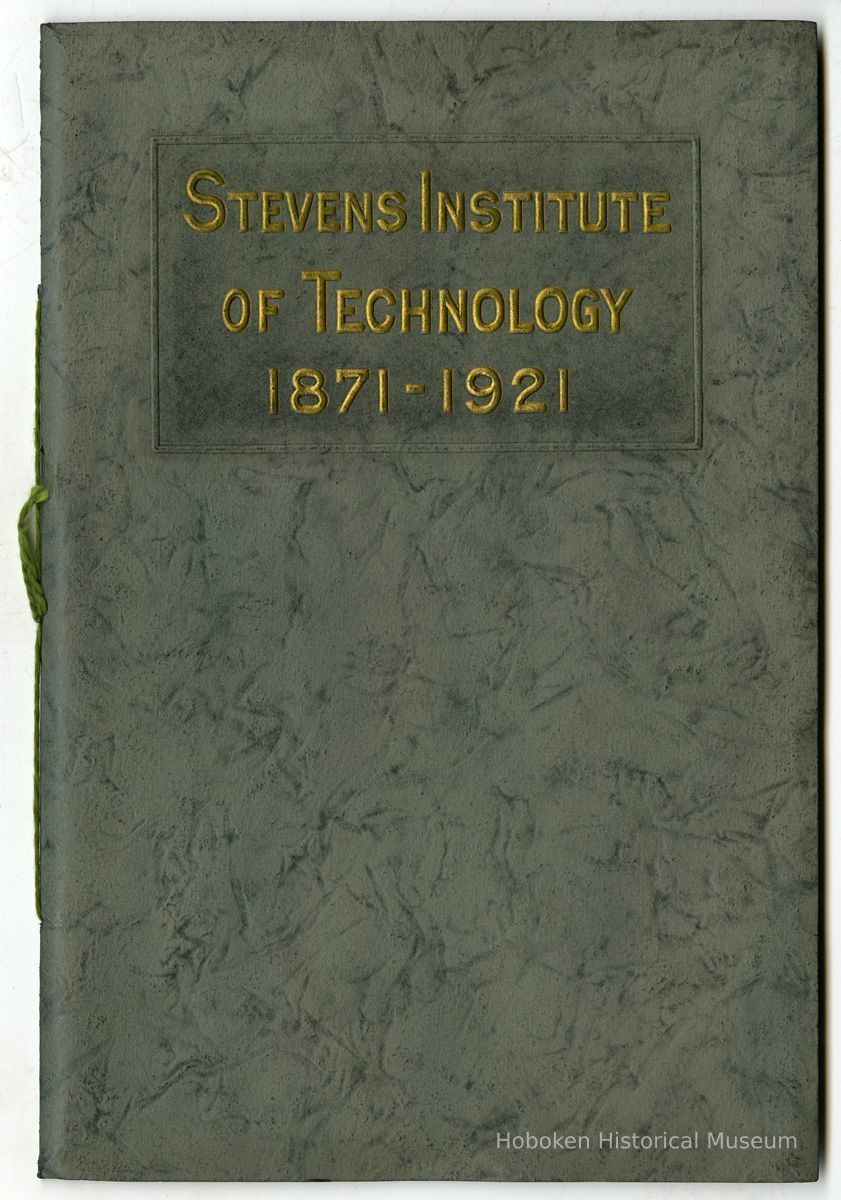

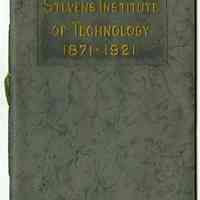
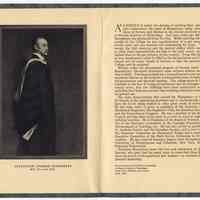
![01 Pg [1] Title](https://d3f1jyudfg58oi.cloudfront.net/11047/image/49b42270-fada-11ed-a641-b3912f9925a9-uFg2G1C.tn.jpg)
![02 Pg [2-3]](https://d3f1jyudfg58oi.cloudfront.net/11047/image/4ae50150-fada-11ed-a641-b3912f9925a9-uFg2HzZ.tn.jpg)
![03 Pg [4-5]](https://d3f1jyudfg58oi.cloudfront.net/11047/image/4c165560-fada-11ed-a641-b3912f9925a9-uFg2H84.tn.jpg)
![04 Pg [6-7]](https://d3f1jyudfg58oi.cloudfront.net/11047/image/4d47a970-fada-11ed-a641-b3912f9925a9-uFg2IDD.tn.jpg)
![05 Pg [8-9]](https://d3f1jyudfg58oi.cloudfront.net/11047/image/4e79c0d0-fada-11ed-a641-b3912f9925a9-uFg2I9n.tn.jpg)
![06 Pg [10-11]](https://d3f1jyudfg58oi.cloudfront.net/11047/image/4faa78a0-fada-11ed-a641-b3912f9925a9-uFg2JFH.tn.jpg)
![07 Pg [12-13]](https://d3f1jyudfg58oi.cloudfront.net/11047/image/50dbccb0-fada-11ed-a641-b3912f9925a9-uFg2JiQ.tn.jpg)
![08 Pg [14-15]](https://d3f1jyudfg58oi.cloudfront.net/11047/image/520d20c0-fada-11ed-a641-b3912f9925a9-uFg2KKn.tn.jpg)
![09 Pg [16-17]](https://d3f1jyudfg58oi.cloudfront.net/11047/image/533ec2f0-fada-11ed-a641-b3912f9925a9-uFg2KkD.tn.jpg)
![10 Pg [18-19]](https://d3f1jyudfg58oi.cloudfront.net/11047/image/54703e10-fada-11ed-a641-b3912f9925a9-uFg2LRw.tn.jpg)
![11 Pg [20-21]](https://d3f1jyudfg58oi.cloudfront.net/11047/image/55a11cf0-fada-11ed-a641-b3912f9925a9-uFg2Lmq.tn.jpg)
![12 Pg [22-23]](https://d3f1jyudfg58oi.cloudfront.net/11047/image/56d27100-fada-11ed-a641-b3912f9925a9-uFg2MXx.tn.jpg)
![13 Pg [24-25]](https://d3f1jyudfg58oi.cloudfront.net/11047/image/58039e00-fada-11ed-a641-b3912f9925a9-uFg2Moi.tn.jpg)
![14 Pg [26-27]](https://d3f1jyudfg58oi.cloudfront.net/11047/image/5934f210-fada-11ed-a641-b3912f9925a9-uFg2NQb.tn.jpg)
![15 Pg [28-29]](https://d3f1jyudfg58oi.cloudfront.net/11047/image/5a666d30-fada-11ed-a641-b3912f9925a9-uFg2Nm5.tn.jpg)
![16 Pg [30-31]](https://d3f1jyudfg58oi.cloudfront.net/11047/image/5b985d80-fada-11ed-a641-b3912f9925a9-uFg2OQl.tn.jpg)
![17 Pg [32-33]](https://d3f1jyudfg58oi.cloudfront.net/11047/image/5cc8ee40-fada-11ed-a641-b3912f9925a9-uFg2Opz.tn.jpg)
![18 Pg [34-35]](https://d3f1jyudfg58oi.cloudfront.net/11047/image/5dfa1b40-fada-11ed-a641-b3912f9925a9-uFg2PUZ.tn.jpg)
![19 Pg [36-37]](https://d3f1jyudfg58oi.cloudfront.net/11047/image/5f2bbd70-fada-11ed-a641-b3912f9925a9-uFg2Pts.tn.jpg)
![20 Pg [38-39]](https://d3f1jyudfg58oi.cloudfront.net/11047/image/605cea70-fada-11ed-a641-b3912f9925a9-uFg2QZt.tn.jpg)
![21 Pg [40-41]: the Alumni](https://d3f1jyudfg58oi.cloudfront.net/11047/image/618e3e80-fada-11ed-a641-b3912f9925a9-uFg2RyY.tn.jpg)
![22 Pg [42-43]](https://d3f1jyudfg58oi.cloudfront.net/11047/image/62bf9290-fada-11ed-a641-b3912f9925a9-uFg2R7l.tn.jpg)
![23 Pg [44-45]](https://d3f1jyudfg58oi.cloudfront.net/11047/image/63f0bf90-fada-11ed-a641-b3912f9925a9-uFg2Rtt.tn.jpg)
![24 Pg [46-47]](https://d3f1jyudfg58oi.cloudfront.net/11047/image/65223ab0-fada-11ed-a641-b3912f9925a9-uFg2Sah.tn.jpg)
![25 Pg [48-49]: The Stevens Family; A Family of Engineers](https://d3f1jyudfg58oi.cloudfront.net/11047/image/66538ec0-fada-11ed-a641-b3912f9925a9-uFg2THg.tn.jpg)
![26 Pg [50-51]](https://d3f1jyudfg58oi.cloudfront.net/11047/image/6785f440-fada-11ed-a641-b3912f9925a9-uFg2Tfn.tn.jpg)
![27 Pg [52-53]](https://d3f1jyudfg58oi.cloudfront.net/11047/image/68b65df0-fada-11ed-a641-b3912f9925a9-uFg2UMe.tn.jpg)
![28 Pg [54-55]](https://d3f1jyudfg58oi.cloudfront.net/11047/image/69e7b200-fada-11ed-a641-b3912f9925a9-uFg2U4M.tn.jpg)
![29 Pg [56-57]](https://d3f1jyudfg58oi.cloudfront.net/11047/image/6b190610-fada-11ed-a641-b3912f9925a9-uFg2VN0.tn.jpg)
